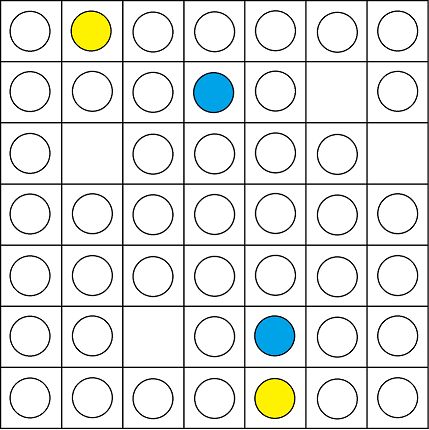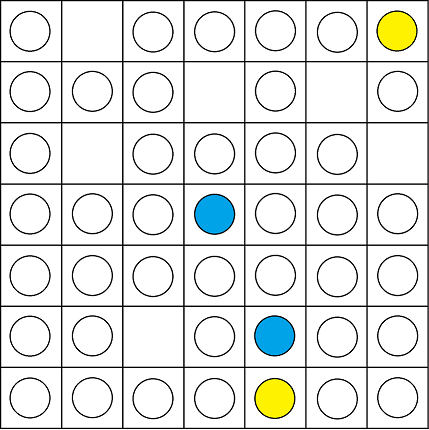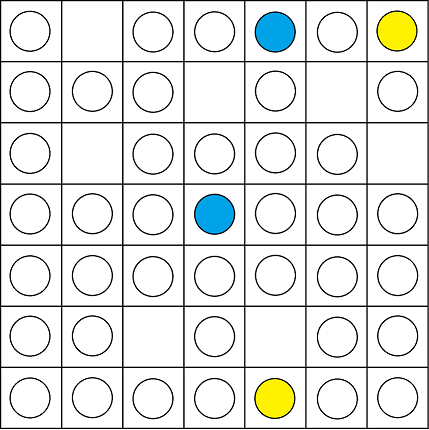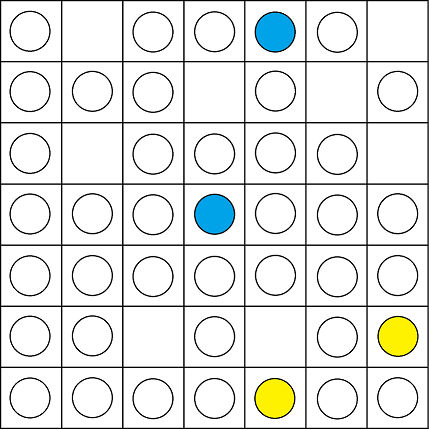
Blue's turn.
This is going to be a complete game of Beach Buttons/Runners (made some time ago).
It's not thrilling but it's a good illustration of the
way it works.
If you want, you could copy the images, then watch
them in some image program, tabbing through in a sort of animation.

Yellow's turn.

Blue's turn.

Yellow's turn.

Blue's turn.

Yellow's turn.

Blue's turn.

Yellow's turn.

Blue's turn.
During these earlier phases you move pretty much randomly. Just don't make
the stupid move that leads to one of your runners being blockaded.

Upper blue moved down.
Yellow's turn.

Upper yellow moves left ish.
Blue's turn.

Lower blue moves down .. to the top.
Yellow's turn.

Upper yellow moves up .. to the bottom.
Blue's turn.

Upper blue moved down.
During a turn you are trying to move your pieces to positions with a number of
branches, preferably with long paths to go down. You also want to keep an eye on
whether you can squeeze the options for your opponent, and whether your opponent can
do the same thing to you.
Yellow's turn.

Bottom yellow moves left.
Blue's turn.

Bottom blue moves right.
Yellow's turn.

Bottom yellow moves left.
Players must use their brains to play this game. However, I would not describe it
as tense, or headhurty.
Blue's turn.

Right blue moves right, winds up on the other side.
Yellow's turn.

Left yellow moves up.
Beach Buttons has been rebranded as Runners. Was that a good idea?
Beach Buttons is cute, but it raises questions. Runners is straightforward.
Blue's turn.

Right blue moves down.
Yellow's turn.

Right yellow moves right, winds up on other side.
Blue's turn.

Right blue moves right.
Yellow's turn.

Right yellow goes up.
Blue's turn.

Right blue goes down.
Time to start thinking of routes that will work for the long term.
Yellow's turn.

Left yellow goes left, winds up on the other side.
We're sort of at the halfway mark, with 24 positions no longer available.
Blue's turn.
Let's talk construction.
I like this white board. Something hard, but I
don't know which material. We could have the black lines. However, an alternate
approach is to have no lines, but empty circles for positions.
Could get creative with that.
In practise you would most likely make your own board out of (laminated?) paper.
Note that a piece of paper on a hard surface would have the "clunk".
I wonder what it would be like to have a transparent board. Maybe there's a
reason nobody does this.
White glass pieces.
Transparent pieces are an option, but probably not. Blue and yellow glass
pieces could be used for the runners. An alternate approach is to use the classic
plastic colourful pawns like in an old roll and move game. I think the glass
pieces are best.
And, again, there are the pros and cons of doing a computer version of this.
If you can move the whole board on the screen you will no longer be puzzled by this
business of going right and winding up on the left. On the other hand, you've lost
the various charms of a tactile game played with another person.

Right blue goes down, winds up at the top.
Yellow's turn.

Left yellow goes up.
Blue's turn.

Left blue goes down.
Yellow's turn. Are you starting to think of where blue will go,
or is that too much work at this time?

Left yellow goes up, winds up at bottom.
Blue's turn.

Right blue moves left. Left blue probably should have moved instead, because
right blue's path will not be blocked.
Yellow's turn.


Right yellow goes up.
Maybe a resin or plastic board.
Blue's turn.


Left blue goes left, winds up on the right.
Yellow's turn. I know things are confusing, but I also know we will soon run out
of options.


Right yellow goes right, winds up on left.
Are you getting an idea of what it would be like as an online game?
Unlike this, you could move the board around fluidly, within your control.
Blue's turn.


Right blue moves down, winds up at the top.
Yellow's turn.


Left yellow goes up. The game is going to start playing itself soon.
Blue's turn.

Top blue goes left.
Yellow's turn.

Bottom yellow goes up.
Blue's turn.

Top blue goes down.
Yellow's turn.

Bottom yellow goes right. That blue piece is done.
Blue's turn.
"This is a blockade game without the bugs of other blockade game concepts."
What are those bugs? One is you can get what I call a bald spot in the middle, as
pieces are more likely to go to the middle to move around. Also, if you have a blockade
game where pieces are not removed, then there is a risk that the game could drone on forever, not ending.
Like the Vietnamese game.








Yellow made the last move, and blue can not move. Yellow won. There can be
a miniscule number of pieces remaining at the end of a game, which makes sense
because players have been choosing routes that will take them farthest.



















































